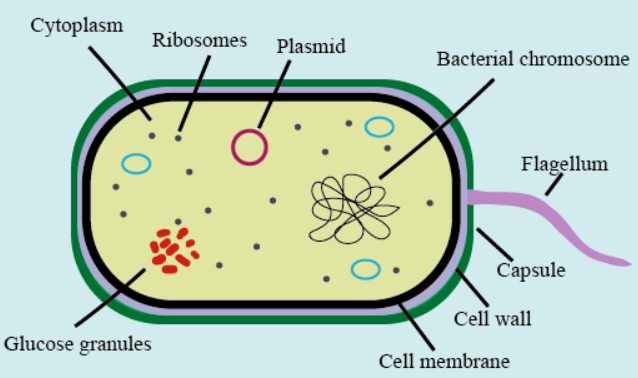
Do bacteria have ER (Endoplasmic Reticulum)?
Answer
459k+ views
Hint: Like lysosomes, mitochondria, and Golgi apparatus endoplasmic reticulum is also a membrane-bound organelle and in prokaryotic organisms the membrane-bound organelles are absent.
Complete answer:
No, bacteria do not have endoplasmic reticulum because bacteria is a prokaryotic organism that lacks member bound organelles such as the nucleus, endoplasmic reticulum, mitochondria, lysosomes, Golgi apparatus, etc. Prokaryotes do not have a distinct nucleus but the genetic materials are present in the form of a single circular DNA strand located in the cytoplasm.
-A large domain of prokaryotic microorganisms is constituted by bacteria which are having a number of shapes, ranging from spheres to rods and spirals.
-A cell membrane surrounding the bacterial cell encloses the contents of the cell and acts as a barrier to hold nutrients, like proteins and other essential components of the cytoplasm within the bacterial cell.
-A multi-component cytoskeleton is possessed by bacteria to control the localization of proteins and nucleic acids within the cell and also to manage the process of cell division.
-The general lack of internal membranes in bacteria shows that the reactions, like electron transport, occur across the cell membrane between the cytoplasm and the periplasm the
outside of the cell.
-The cytoplasm is a gel-like material mainly composed of water and it also contains enzymes, salts, cell components, and various organic molecules.
-The ribosome is a cell structure that is responsible for the production of protein.
Nucleoid: This is the area of the cytoplasm that contains the single DNA molecule of cytoplasm.
-Except for the bacteria that belong to genus mycoplasma and thermoplastic the cell wall is present in all the existing bacterias.
-The glycocalyx is found only in some types of prokaryotes; it is a covering made up of glycoprotein-polysaccharide and it surrounds the cell membranes.
Note:
-Bacteriology is a branch of microbiology that deals with the study of bacteria known as bacteriology, a branch of microbiology.
-In bacteria, the cell wall is the outer covering that protects the bacterial cell and is responsible for the definite shape of the bacteria.
-Cytoplasmic inclusions are present in the prokaryotes; these are the inclusion bodies like ribosomes and larger masses that are scattered in the cytoplasmic matrix.

Complete answer:
No, bacteria do not have endoplasmic reticulum because bacteria is a prokaryotic organism that lacks member bound organelles such as the nucleus, endoplasmic reticulum, mitochondria, lysosomes, Golgi apparatus, etc. Prokaryotes do not have a distinct nucleus but the genetic materials are present in the form of a single circular DNA strand located in the cytoplasm.
-A large domain of prokaryotic microorganisms is constituted by bacteria which are having a number of shapes, ranging from spheres to rods and spirals.
-A cell membrane surrounding the bacterial cell encloses the contents of the cell and acts as a barrier to hold nutrients, like proteins and other essential components of the cytoplasm within the bacterial cell.
-A multi-component cytoskeleton is possessed by bacteria to control the localization of proteins and nucleic acids within the cell and also to manage the process of cell division.
-The general lack of internal membranes in bacteria shows that the reactions, like electron transport, occur across the cell membrane between the cytoplasm and the periplasm the
outside of the cell.
-The cytoplasm is a gel-like material mainly composed of water and it also contains enzymes, salts, cell components, and various organic molecules.
-The ribosome is a cell structure that is responsible for the production of protein.
Nucleoid: This is the area of the cytoplasm that contains the single DNA molecule of cytoplasm.
-Except for the bacteria that belong to genus mycoplasma and thermoplastic the cell wall is present in all the existing bacterias.
-The glycocalyx is found only in some types of prokaryotes; it is a covering made up of glycoprotein-polysaccharide and it surrounds the cell membranes.
Note:
-Bacteriology is a branch of microbiology that deals with the study of bacteria known as bacteriology, a branch of microbiology.
-In bacteria, the cell wall is the outer covering that protects the bacterial cell and is responsible for the definite shape of the bacteria.
-Cytoplasmic inclusions are present in the prokaryotes; these are the inclusion bodies like ribosomes and larger masses that are scattered in the cytoplasmic matrix.

Latest Vedantu courses for you
Grade 10 | CBSE | SCHOOL | English
Vedantu 10 CBSE Pro Course - (2025-26)
School Full course for CBSE students
₹37,300 per year
Recently Updated Pages
Master Class 11 Business Studies: Engaging Questions & Answers for Success

Master Class 11 Economics: Engaging Questions & Answers for Success

Master Class 11 Accountancy: Engaging Questions & Answers for Success

Master Class 11 Computer Science: Engaging Questions & Answers for Success

Master Class 11 English: Engaging Questions & Answers for Success

Master Class 11 Maths: Engaging Questions & Answers for Success

Trending doubts
Which one is a true fish A Jellyfish B Starfish C Dogfish class 11 biology CBSE

Difference Between Prokaryotic Cells and Eukaryotic Cells

1 ton equals to A 100 kg B 1000 kg C 10 kg D 10000 class 11 physics CBSE

1 Quintal is equal to a 110 kg b 10 kg c 100kg d 1000 class 11 physics CBSE

One Metric ton is equal to kg A 10000 B 1000 C 100 class 11 physics CBSE

How much is 23 kg in pounds class 11 chemistry CBSE




